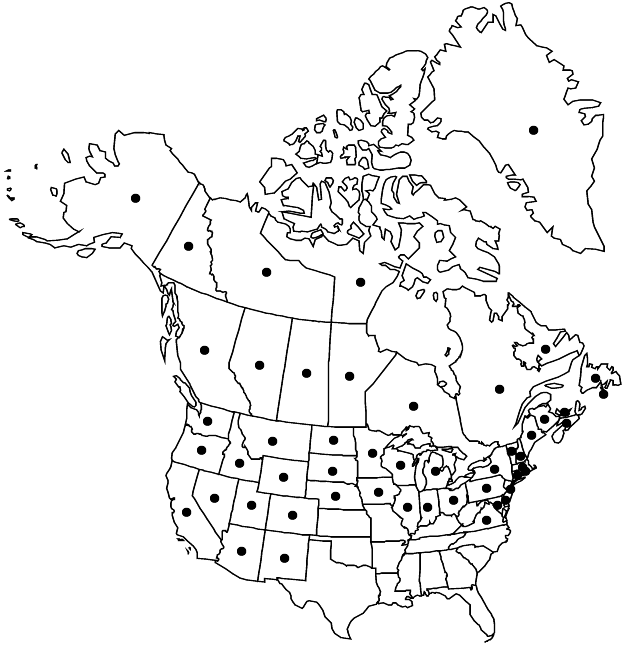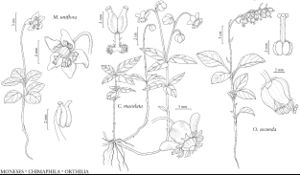Difference between revisions of "Orthilia secunda"
Amer. Midl. Naturalist 7: 134. 1921,.
FNA>Volume Importer |
FNA>Volume Importer |
||
| Line 13: | Line 13: | ||
|name=Orthilia secunda subsp. obtusata | |name=Orthilia secunda subsp. obtusata | ||
|authority=(Turczaninow) Böcher | |authority=(Turczaninow) Böcher | ||
| − | }}{{Treatment/ID/Synonym | + | }} {{Treatment/ID/Synonym |
|name=Orthilia secunda var. obtusata | |name=Orthilia secunda var. obtusata | ||
|authority=(Turczaninow) House | |authority=(Turczaninow) House | ||
| − | }}{{Treatment/ID/Synonym | + | }} {{Treatment/ID/Synonym |
|name=Pyrola secunda subsp. obtusata | |name=Pyrola secunda subsp. obtusata | ||
|authority=(Turczaninow) Hultén | |authority=(Turczaninow) Hultén | ||
| − | }}{{Treatment/ID/Synonym | + | }} {{Treatment/ID/Synonym |
|name=Pyrola secunda var. obtusata | |name=Pyrola secunda var. obtusata | ||
|authority=Turczaninow | |authority=Turczaninow | ||
| Line 37: | Line 37: | ||
|elevation=10-3200 m | |elevation=10-3200 m | ||
|distribution=Greenland;St. Pierre and Miquelon;Alta.;B.C.;Man.;N.B.;Nfld. and Labr.;N.W.T.;N.S.;Nunavut;Ont.;P.E.I.;Que.;Sask.;Yukon;Alaska;Ariz.;Calif.;Colo.;Conn.;Del.;Idaho;Ill.;Ind.;Iowa;Maine;Md.;Mass.;Mich.;Minn.;Mont.;Nebr.;Nev.;N.H.;N.J.;N.Mex.;N.Y.;N.Dak.;Ohio;Oreg.;Pa.;R.I.;S.Dak.;Utah;Vt.;Va.;Wash.;Wis.;Wyo.;Mexico;Central America (Guatemala);Eurasia. | |distribution=Greenland;St. Pierre and Miquelon;Alta.;B.C.;Man.;N.B.;Nfld. and Labr.;N.W.T.;N.S.;Nunavut;Ont.;P.E.I.;Que.;Sask.;Yukon;Alaska;Ariz.;Calif.;Colo.;Conn.;Del.;Idaho;Ill.;Ind.;Iowa;Maine;Md.;Mass.;Mich.;Minn.;Mont.;Nebr.;Nev.;N.H.;N.J.;N.Mex.;N.Y.;N.Dak.;Ohio;Oreg.;Pa.;R.I.;S.Dak.;Utah;Vt.;Va.;Wash.;Wis.;Wyo.;Mexico;Central America (Guatemala);Eurasia. | ||
| − | |discussion=<p>Plants in open, alpine and arctic habitats often have leaf blades orbiculate to orbiculate-ovate, 10–20 mm, apices obtuse, anthers ca. 1 mm, and styles 3–4.5 mm, and have been called Orthilia secunda subsp. obtusata. E. Haber (1972) concluded that these characters vary too freely among populations to warrant distinction.</p><!-- | + | |discussion=<p>Plants in open, alpine and arctic habitats often have leaf blades orbiculate to orbiculate-ovate, 10–20 mm, apices obtuse, anthers ca. 1 mm, and styles 3–4.5 mm, and have been called <i>Orthilia secunda</i> subsp. obtusata. E. Haber (1972) concluded that these characters vary too freely among populations to warrant distinction.</p><!-- |
--><p>The Southern Carrier of British Columbia made a decoction from the roots, which they used as an eyewash (D. E. Moerman 1998).</p> | --><p>The Southern Carrier of British Columbia made a decoction from the roots, which they used as an eyewash (D. E. Moerman 1998).</p> | ||
|tables= | |tables= | ||
| Line 62: | Line 62: | ||
|publication year= | |publication year= | ||
|special status= | |special status= | ||
| − | |source xml=https://jpend@bitbucket.org/aafc-mbb/fna-data-curation.git/src/ | + | |source xml=https://jpend@bitbucket.org/aafc-mbb/fna-data-curation.git/src/8f726806613d60c220dc4493de13607dd3150896/coarse_grained_fna_xml/V8/V8_733.xml |
|subfamily=Ericaceae subfam. Monotropoideae | |subfamily=Ericaceae subfam. Monotropoideae | ||
|genus=Orthilia | |genus=Orthilia | ||
Revision as of 18:08, 18 September 2019
Plants rhizomatous, 1.2–2.7(–3.3) dm. Leaves: petiole 4–20 mm, channeled adaxially, glabrous; blade dull and light green abaxially, shiny and green adaxially, (10–)20–47(–58) × 7–28(–35) mm, base rounded to acute, apex rounded to acute. Inflorescences (2–)3–29-flowered; peduncle 10–20(–25) cm, peduncular bracts absent or 2–7, subulate to narrowly or broadly lanceolate, 3–9 × 1–2 mm, membranous, margins entire or erose-denticulate; inflorescence bracts subulate to lanceolate-ovate or narrowly ovate, ca. as long as pedicels they subtend, 4–9 × 0.4–1.8 mm, herbaceous. Pedicels (1–)3–7(–9) mm. Flowers: calyx lobes appressed or spreading in fruit, entirely green or margins hyaline to white or pinkish, 0.5–1.5 × 0.5–1.3 mm, margins erose-denticulate, sometimes obscurely so, apex rounded to obtuse; petals broadly ovate, 4.5–6 × 3–4 mm, margins erose-denticulate or irregularly toothed; stamens 4–8 mm; filament base 0.1–0.3 mm wide; anthers 1.2–1.8 mm, thecae tan or light brown, pores 0.2–0.5 × 0.2–0.4 mm; ovary smooth; style 3–5(–7) mm; stigma 1.4–2 mm wide. Capsules depressed-globose, 3–5 × 4–6 mm. 2n = 38.
Phenology: Flowering Jun–Aug.
Habitat: Dry to moist, coniferous, mixed, and deciduous forests, bogs, arctic and alpine tundra
Elevation: 10-3200 m
Distribution

Greenland, St. Pierre and Miquelon, Alta., B.C., Man., N.B., Nfld. and Labr., N.W.T., N.S., Nunavut, Ont., P.E.I., Que., Sask., Yukon, Alaska, Ariz., Calif., Colo., Conn., Del., Idaho, Ill., Ind., Iowa, Maine, Md., Mass., Mich., Minn., Mont., Nebr., Nev., N.H., N.J., N.Mex., N.Y., N.Dak., Ohio, Oreg., Pa., R.I., S.Dak., Utah, Vt., Va., Wash., Wis., Wyo., Mexico, Central America (Guatemala), Eurasia.
Discussion
Plants in open, alpine and arctic habitats often have leaf blades orbiculate to orbiculate-ovate, 10–20 mm, apices obtuse, anthers ca. 1 mm, and styles 3–4.5 mm, and have been called Orthilia secunda subsp. obtusata. E. Haber (1972) concluded that these characters vary too freely among populations to warrant distinction.
The Southern Carrier of British Columbia made a decoction from the roots, which they used as an eyewash (D. E. Moerman 1998).
Selected References
None.
